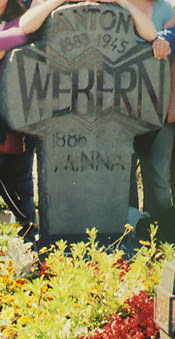On last December 3rd I blogged a piece about the Austrian composer Anton von Webern, and wished that I could find a picture of his gravestone. On January 12 a man in the Philippines sent me the following picture, which I took to be of Webern's grave marker.
A subsequent Google search by another reader led to a picture of what was much more certainly Webern's grave in Mittersill, Austria; a post with the picture mentioned it being a group of students visiting Webern's grave in Mittersill.
Webern lived in Vienna. Though Catholic he was suspected of being Jewish and was required to prove that his blood was pure Aryan. Still, though he was certainly not an anti-Semite, he supported the Nazi party, hoping probably that this would keep him and his family safe. Then, because his compositions were avante garde, Webern was deemed degenerate; this led to his being sacked from his conducting job. His one son, a soldier, was killed on the Eastern front. Some seven months later, the war now over, Anton Webern, despite a curfew, stepped outside his home to smoke a cigar. In a careless situation of mistaken identity, Webern was shot dead by an American soldier whose unit was investigating a case of black marketing.
It's been reported that the soldier who shot Webern lived with deep remorse. Tragedy begot tragedy; that soldier died some ten years later from the effects of alcoholism.
***
I wrote to the Burgermeister of Mittersill. He kindly responded, saying that this is a plaque attached to the house in Mittersill in which Webern lived, and that it was a gift of Anna Mahler, the daughter of the another famous Viennese composer Gustav Mahler.
***
The palindrome, I learn, is renowned; it is called Sator Square, and its earliest known appearance was found in the ruins of Pompeii. There are numerous legends as to the meaning of the words, including one which claims that the words are "mystical names" for the nails pulled from Christ's body. Others have deemed the Sator Square to be magical ... it was believed by some that the devil would become confused by the repetition of the letters; keeping a palindrome near you, so it went, kept the devil away. Further claims: the Sator Square will put out fires; the Sator Square will remove jinxes; the Sator Square will remove fevers; the Sator Square will protect against witchcraft. If you bring a Sator Square along while traveling it will help prevent fatigue. I think I'll tuck one into my wallet.
Otherwise, I'll leave it at that ... and let's hope Dan Brown never comes across the very idea lest it inspire him to write another novel as dreadful as The Da Vinci Code.



Interesting- and thank you!
ReplyDeleteALSO, check this- at the 30 minute mark
ReplyDeletehttps://www.youtube.com/watch?v=fe-uFR_OfQ0
he kind of rushes through the translation- something to do with the sower and the reaper and...?